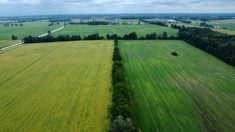Canadian agriculture has huge opportunity, but the heavy lifting to meet a federal government goal of increasing exports to $75 billion by 2025, has barely begun.
A recent gathering of agri-food policy influencers heard that areas that need work across the sector include:
- Finding enough skilled labour to meet the goal
- Governments that can communicate across ministries, but that also know when to get out of the way
- Continued growth in trade deals, and in growing the capacity to export among agri-food businesses
Read Also

Defence investments could benefit agriculture
A bump in Canada’s NATO spending commitments could lead to infrastructure investments that would benefit rural areas
Why it matters: Agriculture and food has the attention of government in a way it never has before, but there’s a sense that there’s only a certain amount of time to show progress before attention moves to other economic priorities.
Old mindsets say that agriculture is an industry of the past and that there isn’t money to be made, said Dominic Barton, chair, of the Federal Advisory Council on Economic Growth and a global managing partner at McKinsey. He’s credited with pushing agriculture to the top of the agenda as a future builder of Canadian prosperity.
The old mindsets are “completely wrong,” he said. “The agriculture sector has outperformed the market historically.”
Barton moderated a panel that included David Dzisiak of Corteva (DowDupont’s newly named agriculture business). Dzisiak has been heavily involved in the Protein Innovation Supercluster – one of five announced in February by the federal government. Also on the panel was Gwen Paddock, senior director of agriculture and resource industry with RBC, Carla Ventin, vice-president of government relations with Food & Consumer Products of Canada and Don Buckingham, president and CEO with the Canadian Agri-Food Policy Institute (CAPI).
The event was put on by the Public Policy Forum, an organization that aims to bring together industry and government to have useful policy discussions.
Barton listed Canada’s many advantages that position the country to increase its role as a provider of food to the world.
They include:
- Abundant natural resources;
- Strong network of research and development facilities and universities;
- Sophisticated customer base that stimulates product development;
- Canadian farmers are early adopters of technology;
- Reliable access to capital and inputs;
- Lowest use of pesticides per hectare;
- Political stability and international good will.
All the positives aside, panel spent more of its time discussing barriers to agri-food growth.
Regulatory restrictions
Canada’s excess of regulations gets in the way of foreign investment, says Barton. It also holds back growth. Regulatory changes here and in the U.S. have made it more difficult to compete over the past decade.
“We’ve had too much, too fast,” said Ventin, referring to increasing regulations. She added that the increases in regulation are not in food safety, which is a priority, but in other areas. Proposed labelling changes by the federal government could cost $1.8 billion to implement, she said.
Chris Forbes, deputy minister of Agriculture and Agri-Food Canada pointed to a regulatory review promised in the 2018 budget as good news for the sector.
Institutionalizing agriculture and food as an economic leader
Barton’s report has coincided with other major government initiatives relating to food and agriculture, including a developing National Food Policy.
With those initiatives, along with the Canadian Agricultural Partnership being recently launched as a five-year framework for all federal and provincial agriculture spending, there’s an opportunity to bring more government ministries together around agriculture and food.
CAPI has proposed a whole government body that looks at issues relating to agriculture and food across ministries. “It would have a seat at the highest levels of government,” said Ventin.
The federal government recently created five innovation superclusters bringing together industry, including players who wouldn’t usually work closely together, funders and researchers. Four of the five have a food component, said Barton.
The National Food Policy has helped break down some of the silos in government and the agri-food sector, said Buckingham, with numerous government agencies involved, and organizations ranging from anti-poverty to agriculture production in the room. He said there is momentum to solving the silo issues in agriculture and food.
Making exports what we do
The growth potential for Canadian agriculture is in markets outside the country. We’re behind where we should be, said Barton, lamenting that the Netherlands, with its limited land base, is third in global food exports.
Exporting more food will require a change in thinking for many businesses, said Paddock, who pointed out that only four per cent of Canadian small and medium-sized businesses export, and even fewer export beyond the United States.
“We have to demystify exporting and trade for businesses. If businesses are not ready to get out there and develop markets, then we may lose the opportunity,” she said.
Canada has recently ratified the CETA trade agreement with Europe and signed onto the CPTPP trade deal with Pacific nations, but Barton said more deals are needed. He said that federal Finance Minister Bill Moreau challenged him that Canada needs to ramp up exports without trade deals, as they are long in negotiation. Barton said an option is for Canadian exporters to find focused opportunities and mentioned Chongqing, a Chinese city of 35 million people, where focused market development work could result in significant exports. The Ontario Corn-Fed Beef program, for example, has significantly increased its exports to China by focusing heavily on the Shanghai market.
In order to export more, Canada’s agriculture sector needs to become more productive, said Barton, as our productivity numbers don’t match up with those of major competitors like Brazil or the Netherlands.
Building capacity
There are Canadian companies with interest in their products from Chinese markets, but they have problems getting their product out of Canada, to China, said RBC Vice President John Stackhouse. The rail system is full and increasing in cost and not enough truck drivers can be found, he said.
Dzisiak made a similar point, lauding our ability to get grain to market, but panning the fact the system is 100 years old and needs an update.
There’s also a need to build human resources capital, with a representative of the Food Processing Human Resources Council relaying stories about processors who have had to go elsewhere because they couldn’t find enough workers in Canada.
Some human resource problems will be solved by artificial intelligence and automation, but far from all of them.
Meeting organizers had to turn people away, and that, along with the enthusiasm in the room shows the level of excitement surrounding agriculture and food, said Buckingham.
The challenge continues to be building agriculture’s moment of excitement into long-term success.
Farmers undaunted by export challenge
The Canadian Agri-Food Policy Institute (CAPI) asked farmers, food processors and universities what they thought about the federal government’s challenge to increase agri-food exports to $70 billion by 2025.
Here’s what they said, according to Don Buckingham, CAPI president and CEO:
- Producers and processors are not afraid of the targets. The first thing we learned is that there’s a real sense of energy in the sector. The export growth target is part of what is propelling the sector to be excited.
- There is some concern around the ability to get the crop to market, both from a transportation and trade perspective.
- There will need to be changes in the way farmers do business if they are to significantly increase production and they want to make sure their grandchildren have farms to grow food on.
- If the agriculture sector achieves production and export increases, can public trust still be maintained? The need for transparency was emphasized.














